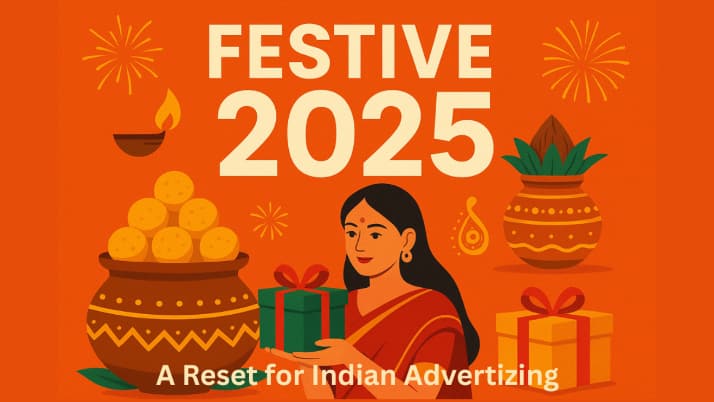Festivals in India have always been a big opportunity for marketers, but this year feels different. Why? Because a Rs 5,000 crore portion of advertising, the once-popular online gaming category, has disappeared overnight.

Festive 2025: As gaming ads exit, brands reset strategies with sharper regional, hyperlocal, and consumer-first bets to win the season. (Source: AI Image)
The competition for consumer attention has grown tougher. Every brand, from FMCG giants to gifting platforms and quick commerce apps, is adjusting its festive strategy.
Here’s the situation: India’s festive quarter has always been crowded. There are too many brands, too many campaigns, and not enough time to stand out. But now, with gaming dollars gone, the landscape has changed. The winners won’t just be the loudest. They will be the ones who can focus more sharply, connect regionally, and create a strong emotional impact.
“Overall advertising budgets are expected to grow around 15–20%, driven by intensified competition for premium slots on marquee national properties like Bigg Boss, KBC, and the Pro Kabaddi League,” says Russhabh R Thakkar, Founder and CEO, Frodoh, an adtech company.
He says the void left by gaming isn’t just a reallocation; it seems like a reset. “Brands are heavily investing in regional language TV, vernacular OTT platforms, and local influencer networks tied to key festivals such as Onam, Durga Puja, and Diwali. Expect 2025 to be remembered less for the shortfall in one category and more for how India’s festive advertising truly became a multi-lingual, multi-platform celebration of consumer culture,” says Thakkar.
So, where does that leave brands? Let’s start with food. For companies like ZOFF Foods, the festive quarter isn’t optional; it is more like survival.
“At ZOFF Foods, we are increasing our festive marketing spends by around 20%–25% compared to last year,” says Akash Agrawalla, co-founder of the company. The money is being funnelled into digital campaigns, home-chef collaborations, and targeted retail activations. Why? Because, as Agrawalla puts it, “This season is not just to drive sales but also to create stronger consumer engagement with the brand.”
The growth expectations are equally ambitious. “We expect festive sales to grow by nearly 30% year-on-year,” he says, pointing to consumer demand for “premium, healthy, and innovative” spice blends.
But food is only one piece of the puzzle. Rural demand is where many FMCG players are placing their bets. Aasif Malbari, CFO, Godrej Consumer Products Limited, pointed to the structural shifts underway: “India's rural economy has a huge potential for the FMCG sector. The recent quarters are witnessing robust volume growth surpassing urban areas.” Backed by a good monsoon and rising farm incomes, he expects consumer sentiment to strengthen across categories such as hair colours, home fragrances, and deodorants.
If FMCG is leaning on rural momentum, quick commerce is chasing the opposite end of the spectrum: festive convenience and hyperlocal variety.
Instamart, for instance, is not just stocking up on diyas and sweets; it’s curating eco-friendly idols for Ganesh Chaturthi, and gold coins for Dhanteras. The spokesperson explains, “Instamart is stocking up early across dark stores, scaling staffing and delivery partners to uphold its 10-minute promise. While metros lead demand, Tier-2 and 3 cities are driving a growing share of festive traffic, making this Instamart’s most ambitious festive season yet.”
It’s a striking reminder that festivals aren’t just national, they’re hyperlocal, and that’s where the new battleground lies.
And then, there’s gifting. Once considered a side-show, it has now become a serious business lever.
“We’re witnessing significant growth in the gifting category, especially during the festive season, and we anticipate this trend to continue,” says Avi Kumar, CMO at FNP. The challenge, however, is clutter. “During this period, all brands across categories are highly active, creating significant market clutter. From an ad spend perspective, we are mindful of our investments, ensuring efficiency and maximum impact.”
Kumar is blunt about the stakes: the rise of personalised and experience-driven gifting means the competition is no longer just other gifting platforms, it’s every brand that wants to sneak into the festive shopping cart.
So, what’s the main point here? Whether it’s food brands focusing on engaging recipes, FMCG giants relying on rural sales, Instamart becoming a festive market, or gifting platforms building emotional connections, the common theme is making more focused choices. No one can afford to be bland.
Festive 2025 won’t be remembered for a single big ad campaign or one standout brand. Instead, it will be noted for how every player, from the largest FMCG company to the newest D2C brand, had to refine its approach. Festivals may always be loud, but this year, simply making noise won’t be enough. Precision, timing, and understanding the culture will matter more.
And maybe that’s a good thing. When the clutter gets overwhelming, it's the clarity of strategy that stands out the most.
Empower your business. Get practical tips, market insights, and growth strategies delivered to your inbox
By continuing you agree to our Privacy Policy & Terms & Conditions
